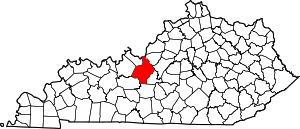Radcliff, Kentucky
Radcliff is a home rule-class city[4] in Hardin County, Kentucky, in the United States. The population was 21,692 at the 2010 census,[5] and in 2019 the estimated population was 22,914.[6] It is included in the Elizabethtown–Fort Knox Metropolitan Area.
Radcliff, Kentucky | |
|---|---|
 Location of Radcliff in Hardin County, Kentucky. | |
| Coordinates: 37°49′48″N 85°56′44″W | |
| Country | United States |
| State | Kentucky |
| County | Hardin |
| Incorporated | 1956[1] |
| Area | |
| • Total | 13.34 sq mi (34.54 km2) |
| • Land | 13.30 sq mi (34.46 km2) |
| • Water | 0.03 sq mi (0.08 km2) |
| Elevation | 771 ft (235 m) |
| Population (2010) | |
| • Total | 21,688 |
| • Estimate (2019)[3] | 22,914 |
| • Density | 1,722.34/sq mi (665.01/km2) |
| Demonym(s) | Radcliffian (citation needed) |
| Time zone | UTC−5 (Eastern (EST)) |
| • Summer (DST) | UTC−4 (EDT) |
| ZIP codes | 40159-40160 |
| Area code(s) | 270 & 364 |
| FIPS code | 21-63912 |
| GNIS feature ID | 0501516 |
| Website | www |
Its economy is largely dominated by the adjacent U.S. Army base Fort Knox and by the nearby city of Elizabethtown. Radcliff's population previously fluctuated greatly depending on the deployments of the units at the base, but the BRAC reorganization of 2005, and the quartering of the U.S. Army's Human Resources Command to Fort Knox has created a larger and more stable population.[7]
Geography
Radcliff is in northern Hardin County at 37°49′48″N 85°56′44″W (37.829918, -85.945541).[8] It is bordered to the north by Fort Knox and to the west by Vine Grove. U.S. Route 31W runs through the east side of the city, leading north 34 miles (55 km) to Louisville and south 11 miles (18 km) to Elizabethtown.
According to the United States Census Bureau, Radcliff has a total area of 12.4 square miles (32.2 km2), of which 12.4 square miles (32.1 km2) are land and 0.04 square miles (0.1 km2), or 0.25%, are water.[5]
The former unincorporated community of Rogersville, named for a local family, is in the southern part of Radcliff along US 31W and Kentucky Route 447.[9]
History
Incorporated in 1956, Radcliff was first settled in 1919, when Horace McCullum subdivided lots along Wilson Avenue and sold them at auction to the highest bidder. McCullum named the new community after Major William Radcliffe, head of the Quartermaster Corps at the newly established Camp Henry Knox. After selling the general store he had opened in the new town, McCullum no longer played a role in its development.
The next significant step in Radcliff's history took place during the 1930s when Fort Knox expanded and dislocated the towns of Stithton and New Stithton, causing various residents and businesses of those communities to move to Radcliff. During World War II, thousands of soldiers trained at Fort Knox and spent their leisure hours at the USO in Radcliff.
Hardin Water District No. 1 was formed in 1953, and became a reality in 1955 with the sale of bonds to finance the project. Today, the water district is the principal source of fresh water to all Hardin County. Radcliff's fire department was established in 1955, with Joseph B. Hutcherson the first fire chief. The Radcliff Civic Club was also organized that year. The city incorporated in March 1956 as a 6th-class city. Radcliff Police Department was formed with officers paid on a fee basis. The population was estimated at 800. Radcliff's population growth over the last 50 years is due to the transient military population, and trends are showing a plateau and decline. At one time, Radcliff was larger than Elizabethtown, but that was short-lived after the 2000 census and more so after the BRAC transformation at the beginning of the 21st century. Starting with 800 in 1956, the Census Bureau reported populations of 3,381 in 1960, 8,281 in 1970, 14,519 in 1980, and 21,961 in 2000.
In 1988, a youth group from the First Assembly of God in Radcliff was involved in the worst drunk-driving accident in U.S. history, a bus accident in which a drunk driver going the wrong way on Interstate 71 hit the group's vehicle, killing 27 people.[10][11]
In mid-October 2011, the city voted to approve alcohol sales, which began in January 2012.
Former Kentucky state representative Mike Weaver was elected mayor in 2014 and took office in 2015 for a four-year term. City council members Barbara Baker, Stan Holmes, Edward L. Palmer, T. W. Shortt, Kim Thompson and Chris Yates were also elected in 2014 and took office in 2015, each for a two-year term.
The November 8, 2016, general election for Radcliff City Council ended with all current councilmembers reelected except Shortt, who had run for Kentucky State Representative. Radcliff community leader and businesswoman Tanya Seabrooks was elected to fill the seat Shortt vacated, defeating five other candidates. She took the oath of office in December 2016 for a two-year term. Shortt was defeated in his bid for state representative by the incumbent, Dean Schamore.
Demographics
| Historical population | |||
|---|---|---|---|
| Census | Pop. | %± | |
| 1960 | 3,384 | — | |
| 1970 | 8,426 | 149.0% | |
| 1980 | 14,656 | 73.9% | |
| 1990 | 19,772 | 34.9% | |
| 2000 | 21,961 | 11.1% | |
| 2010 | 21,688 | −1.2% | |
| Est. 2019 | 22,914 | [3] | 5.7% |
| U.S. Decennial Census[12] | |||
As of the census[13] of 2000, there were 21,961 people, 8,487 households, and 5,856 families residing in the city. The population density was 1,914.1 people per square mile (739.2/km2). There were 9,487 housing units at an average density of 826.9 per square mile (319.4/km2). The racial makeup of the city was 62.76% White, 25.65% African American, 0.61% Native American, 3.52% Asian, 0.41% Pacific Islander, 2.60% from other races, and 4.46% from two or more races. Hispanic or Latino of any race were 5.66% of the population.
There were 8,487 households, out of which 38.5% had children under the age of 18 living with them, 48.7% were married couples living together, 16.1% had a female householder with no husband present, and 31.0% were non-families. 26.0% of all households were made up of individuals, and 6.1% had someone living alone who was 65 years of age or older. The average household size was 2.57 and the average family size was 3.09.
In the city, the population was spread out, with 29.1% under the age of 18, 9.6% from 18 to 24, 32.6% from 25 to 44, 20.0% from 45 to 64, and 8.6% who were 65 years of age or older. The median age was 33 years. For every 100 females, there were 95.0 males. For every 100 females age 18 and over, there were 91.0 males.
The median income for a household in the city was $35,763, and the median income for a family was $41,260. Males had a median income of $30,518 versus $20,982 for females. The per capita income for the city was $16,436. About 11.3% of families and 12.5% of the population were below the poverty line, including 18.0% of those under age 18 and 3.4% of those age 65 or over.
Education
Radcliff has two public secondary schools within its city limits. Most high-schoolers in the city attend North Hardin High School, with some zoned to attend John Hardin High School (which is in a portion of the city served by the Elizabethtown post office).[14] There are also: North Park Elementary, Woodland Elementary, Meadowview Elementary, North Middle School, Radcliff Elementary and the all-grades North Hardin Christian School private school run by Radcliff's Fellowship Independent Baptist Church.
Radcliff has a lending library, a branch of the Hardin County Public Library.[15]
See also
- Other places named Radcliff
References
- Commonwealth of Kentucky. Office of the Secretary of State. Land Office. "Radcliff, Kentucky". Accessed 26 August 2013.
- "2019 U.S. Gazetteer Files". United States Census Bureau. Retrieved July 24, 2020.
- "Population and Housing Unit Estimates". United States Census Bureau. May 24, 2020. Retrieved May 27, 2020.
- "Summary and Reference Guide to House Bill 331 City Classification Reform" (PDF). Kentucky League of Cities. Retrieved December 30, 2014.
- "Geographic Identifiers: 2010 Demographic Profile Data (G001): Radcliff city, Kentucky (revision of 05-03-2012)". American Factfinder. U.S. Census Bureau. Retrieved June 26, 2017.
- "Population and Housing Unit Estimates". Retrieved May 21, 2020.
- Adkins, Ben (August 23, 2010). "BRAC changes at Fort Knox spur development in surrounding area".
- "US Gazetteer files: 2010, 2000, and 1990". United States Census Bureau. 2011-02-12. Retrieved 2011-04-23.
- Rennick, p. 255. Accessed 29 September 2013.
- Copeland, Larry (May 12, 2013). "Survivors recall deadliest drunken-driving crash". USA Today. Retrieved July 13, 2020.
- Yetter, Deborah (May 13, 2018). "Drunk driver silent about Carrollton bus crash despite survivors' pleas". Courier Journal. Retrieved July 13, 2020.
- "Census of Population and Housing". Census.gov. Retrieved June 4, 2015.
- "U.S. Census website". United States Census Bureau. Retrieved 2008-01-31.
- "City of Radcliff Comprehensive Plan 2003: Element Seven, Community Facilities" (PDF). Public Works Department, City of Radcliff, Kentucky. pp. 7–5. Archived from the original (PDF) on 2006-10-05. Retrieved 2009-07-28.
- "Kentucky Public Library Directory". Kentucky Department for Libraries and Archives. Archived from the original on 11 January 2019. Retrieved 5 June 2019.

